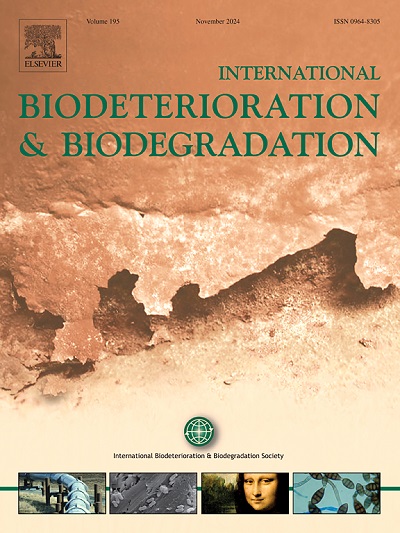Genomics and biodegradation properties of an oleophilic bacterium isolated from shale oil sludge
IF 4.1
2区 环境科学与生态学
Q2 BIOTECHNOLOGY & APPLIED MICROBIOLOGY
International Biodeterioration & Biodegradation
Pub Date : 2025-02-24
DOI:10.1016/j.ibiod.2025.106028
引用次数: 0
Abstract
Shale oil exploitation is accompanied with the generation of a large quantity of oily sludge. In order to provide suitable microbial resources for treating the growing amount of oily sludge, a microbial strain was isolated and purified from the sewage sludge produced in Daqing shale oil field in this study. The isolated strain in the sludge, temporarily termed FM-1, was identified by morphological, biochemical experiments and 16S rDNA sequencing. At the same time, the protein coding genes of the strain FM-1 were classified by genome-wide sequencing and analyzed its genetic characteristics. The degradation effect of FM-1 was detected to C12, C17 and crude oil and sludge samples by gas chromatography and spectrophotometer. The results confirmed that FM-1 was Bacillus proteolyticus. The whole genome sequencing data analysis showed that there were 1495 protein coding genes related to metabolism, including 384 genes for carbohydrate metabolism. All the genes related to the degradation function, such as almA, mdhA, CYPs, ladA, catD, catE and fadE, were enriched in the oxidative phosphorylation signaling pathway, indicating that FM-1 had abundant genes associated with petroleum hydrocarbon degradation. The strain FM-1 could utilize C10-C40 petroleum hydrocarbons as the sole carbon source, and the degradation rate of crude oil was 17.5% in seven days under the experimental conditions. The degradation rate for petroleum hydrocarbon pollutants in shale oil sludge was as high as 91.5% in 28 days. Literature and patent searches found that Bacillus proteolyticus was a kind of new efficient petroleum hydrocarbon degrading bacterium, which had been obtained the Chinese invention patent.

从页岩油泥中分离的嗜油细菌的基因组学和生物降解特性
页岩油开采伴随着大量含油污泥的产生。为了为处理日益增多的含油污泥提供适宜的微生物资源,本研究从大庆页岩油田污水污泥中分离纯化了一株微生物菌株。通过形态学、生化实验和16S rDNA测序对污泥中分离的菌株进行了鉴定,暂时命名为FM-1。同时,通过全基因组测序对菌株FM-1的蛋白编码基因进行分类,并分析其遗传特征。采用气相色谱法和分光光度法检测了FM-1对C12、C17以及原油和污泥样品的降解效果。结果证实FM-1为溶蛋白芽孢杆菌。全基因组测序数据分析显示,与代谢相关的蛋白质编码基因有1495个,其中碳水化合物代谢基因384个。氧化磷酸化信号通路中富集了与降解功能相关的almA、mdhA、CYPs、ladA、catD、catE、fadE等基因,说明FM-1具有丰富的石油烃降解相关基因。菌株FM-1能以C10-C40石油烃为唯一碳源,在实验条件下7 d内对原油的降解率为17.5%。28 d内页岩油泥中石油烃污染物的降解率高达91.5%。文献资料和专利检索发现,水解蛋白芽孢杆菌是一种新型高效石油烃降解菌,已获得中国发明专利。
本文章由计算机程序翻译,如有差异,请以英文原文为准。
求助全文
约1分钟内获得全文
求助全文
来源期刊
CiteScore
9.60
自引率
10.40%
发文量
107
审稿时长
21 days
期刊介绍:
International Biodeterioration and Biodegradation publishes original research papers and reviews on the biological causes of deterioration or degradation.

 求助内容:
求助内容: 应助结果提醒方式:
应助结果提醒方式:


